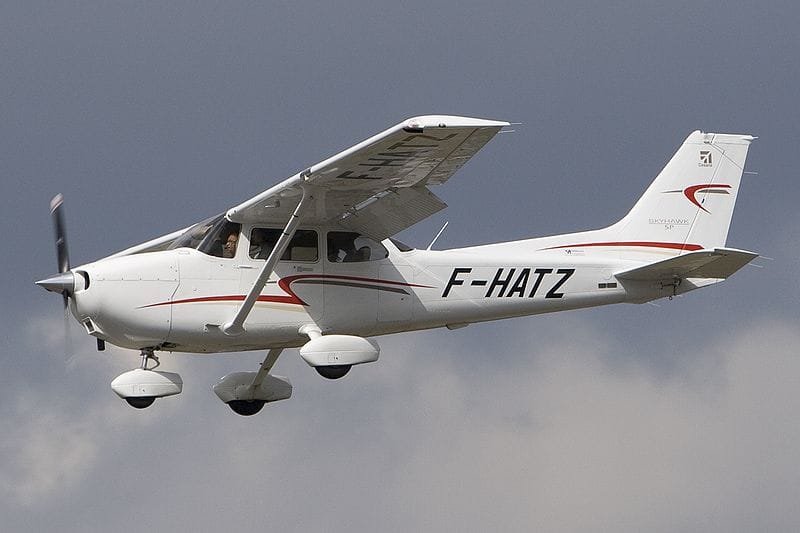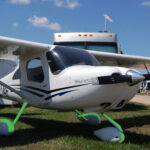Get ready to fasten your seatbelts and take flight into the captivating world of Cessna aircraft! We’ll dive into the secrets behind the legendary Cessna 172, uncover the remarkable endurance of Cessna planes, and explore the fascinating story of how Clyde Cessna’s pioneering spirit sparked this iconic aviation brand. Along the way, we’ll uncover the intriguing origins of Cessna’s name, discover the reasons why these aircraft are trusted by pilots around the globe, and delve into the technical marvels that have made them a cornerstone of aviation. Join us on this enthralling journey through the annals of aviation excellence with Cessna!
Cessna Plane Facts
Ever heard of Cessna? They’re practically synonymous with small aircraft! For decades, they’ve been crafting some of the most recognizable and dependable planes in the sky. Let’s uncover some intriguing facts about this legendary company and the reasons behind their iconic status in the aviation world.
From Humble Beginnings to Aviation Pioneers:
The Cessna story begins in 1911 with a visionary named Clyde Cessna. This Kansas farmer, driven by an unyielding passion for flight, etched his name in aviation history by constructing his own aircraft. His pioneering spirit led him to achieve a remarkable feat: becoming the first person to successfully build and fly an airplane between the Mississippi River and the Rocky Mountains.
Dominating the Skies: A Legacy of Leadership:
Cessna rapidly ascended to prominence in the realm of general aviation, the segment of flying that encompasses personal, training, and recreational purposes. For a significant period, Cessna stood tall as one of the “Big Three” aircraft manufacturers, alongside industry giants Piper and Beechcraft. This esteemed trio earned a reputation for producing aircraft celebrated for their reliability and craftsmanship.
Catering to Every Aviation Need: A Diverse Product Line:
One of the key factors contributing to Cessna’s enduring success lies in its remarkably diverse product line. Whether you were a novice pilot seeking a trusty single-engine trainer like the iconic Cessna 172, an experienced aviator in need of a capable twin-engine aircraft for short hops, or a corporate high-flyer looking for a comfortable and efficient business jet, Cessna likely had an aircraft perfectly tailored to meet those specific requirements.
Embracing Innovation: The Acquisition of Aircraft Radio Corporation:
Cessna’s commitment to staying ahead of the curve in aviation technology was evident in its strategic acquisition of the Aircraft Radio Corporation. This move solidified Cessna’s position as a leader not only in aircraft manufacturing but also in the crucial field of aircraft radios.
A Legacy That Soars: Cessna’s Enduring Impact:
To this day, the Cessna name continues to command respect throughout the aviation community. Their aircraft have become synonymous with dependability, versatility, and impressive performance. Whether you’re a seasoned pilot or someone who dreams of experiencing the freedom of flight, encountering a Cessna is almost inevitable—they’re just that prevalent. Their story serves as a powerful testament to the indomitable spirit of innovation and the enduring allure of conquering the skies.
What are some interesting facts about Cessna?
We’ve covered the basics of Cessna’s impact, but their story goes far beyond the ordinary. Prepare to be amazed by some remarkable achievements that solidify Cessna’s place in aviation history.
The Cessna 172: A Record-Breaking Legacy:
Let’s start with the Cessna 172, a familiar sight in the skies and a favorite among pilots. This aircraft isn’t just a common sight—it holds the prestigious title of the most produced aircraft in history. That’s right, over 43,000 of these airborne marvels have graced the skies! Its popularity can be partially attributed to its revolutionary design. When it debuted in 1956, the Cessna 172 helped make the tricycle landing gear, a feature we often take for granted today, the standard in aircraft design. This innovation significantly simplified the landing process for pilots of all skill levels.
Pushing the Limits of Endurance: A Flight for the Ages:
Buckle up for this one: in 1958, a Cessna 172 achieved the seemingly impossible by staying aloft for an astounding 64 days and 22 hours straight! This remarkable feat set a world record for flight endurance, a testament to the incredible capabilities of both the aircraft and the skilled pilots who pushed it to its limits.
Staying Ahead of the Curve: The Aircraft Radio Corporation Acquisition:
Cessna’s acquisition of the Aircraft Radio Corporation wasn’t just a savvy business move; it was a clear signal of their dedication to technological advancement. By bringing the leading innovator in aircraft radios into the fold, Cessna ensured they remained at the forefront of aviation technology.
The Cessna 172: A Legacy of Continuous Improvement:
The Cessna 172 isn’t content to rest on its laurels. Over the years, it has undergone numerous refinements, each iteration enhancing its safety and performance. For instance, the introduction of circuit breakers in 1964 might seem minor, but it represented a significant leap forward in aircraft safety. By 2015, the Cessna 172 reached a staggering production milestone, with over 100,000 units built. It’s a testament to the enduring legacy of this iconic aircraft.
What is a fact about the Cessna 172?
The Cessna 172 has earned its place among aviation legends. Introduced in 1956, this remarkable aircraft has been soaring the skies for over six decades! In that time, Cessna has manufactured a staggering number of 172s—over 43,000 to be precise. No other airplane in history can claim such a prolific production run.
Why the Enduring Popularity?
The Cessna 172’s enduring appeal lies in its reputation as the “reliable family car of the skies.” It’s renowned for its dependability, ease of operation, and relatively low maintenance costs—crucial factors in the world of aviation. Pilots, especially those still honing their skills, gravitate towards the 172 for its forgiving handling characteristics, excellent visibility from the high-wing design, and stable flight characteristics.
Evolution of an Icon:
Over the years, Cessna has introduced over 40 different variants of the 172, each iteration incorporating refinements and improvements. However, the fundamental elements that have made the 172 so successful remain unchanged: a reliable single engine typically sourced from Lycoming, the now-ubiquitous tricycle landing gear configuration, and the classic high-wing design.
Picture a small airplane in your mind, and chances are you’re envisioning something strikingly similar to the Cessna 172. It’s a testament to the iconic status this aircraft has achieved in the world of aviation.
What are 5 facts about airplanes?
We’ve delved into the specifics of Cessna, but let’s take a moment to appreciate the wonders of airplanes in general. Here are five fascinating facts that highlight the incredible impact these flying machines have had on our world:
1. Airplanes: Connecting the World, One Flight at a Time
Consider this: at this very moment, there are likely around 2 million people soaring above us in airplanes, traversing continents and connecting distant corners of the globe. This constant flow of passengers underscores the pivotal role air travel plays in facilitating international business ventures, reuniting families separated by borders, and offering opportunities to experience diverse cultures.
2. The Jumbo Jet: A Testament to Engineering Prowess
In 1976, the Boeing 747, affectionately known as the jumbo jet, secured its place in aviation history. This colossal aircraft accomplished an unprecedented feat by carrying an astonishing 1,089 passengers on a single flight. The sheer scale of this accomplishment highlights the remarkable capacity and efficiency of these engineering marvels.
3. Breaking the Sound Barrier: The Supersonic Concorde
Imagine traversing the Atlantic Ocean at twice the speed of sound. That’s precisely what the Concorde, a marvel of Anglo-French engineering, was capable of achieving. With a maximum speed of Mach 2.04, the Concorde revolutionized air travel, significantly reducing flight times and ushering in a new era of high-speed international travel.
4. Fuel Efficiency at Altitude: Sipping Fuel, Mile-High Style
You might be surprised to learn that modern airplanes are designed with fuel efficiency as a top priority. In fact, some of the latest aircraft models boast fuel consumption rates as low as 2 liters of fuel per 100 kilometers flown. To put that into perspective, that’s comparable to a car achieving an astounding 117 miles per gallon! This emphasis on fuel efficiency not only benefits the environment but also helps airlines keep ticket prices competitive.
5. Airplanes: Reshaping Our World
Cast your mind back to 1903 when the Wright brothers achieved their groundbreaking first flight. It’s unlikely they could have foreseen the profound impact their invention would have on the world. From revolutionizing warfare to transforming international travel into a commonplace occurrence, airplanes have fundamentally reshaped the way we connect, conduct business, and envision the future.
As technology advances, it begs the question: what does the future hold for these incredible flying machines? Will we witness even faster and more fuel-efficient aircraft? Only time will tell, but one thing is certain: airplanes will continue to play a vital role in shaping our world for generations to come.
What is a Cessna good for?
So, we’ve established that Cessna aircraft are incredibly popular, but what exactly makes them so versatile? Think of Cessna planes as the Swiss Army knives of the aviation world—they’re capable of fulfilling a wide array of roles, from introducing aspiring pilots to the joys of flight to efficiently transporting cargo.
The Go-To Choice for Practicality and Affordability:
If you’re in search of an aircraft that’s known for its ease of handling, dependable performance, and reasonable operating costs, a Cessna is often the ideal solution. It’s no wonder that the Cessna 172, the world’s best-selling aircraft, is a mainstay in flight schools around the globe.
Beyond Flight Training: A Favorite Among Enthusiasts:
Cessna’s appeal extends far beyond the realm of flight training. Many aviation enthusiasts choose Cessna aircraft for personal use. Their reputation for reliability, stable flight characteristics, and relatively low maintenance costs makes them an attractive choice for pilots who value a smooth and enjoyable flying experience without breaking the bank.
Cessna in the Commercial World:
Don’t assume that Cessnas are limited to training and recreational flying. These versatile aircraft have proven their worth in various commercial applications. Businesses rely on Cessnas for air taxi services, cargo transport, and specialized tasks such as aerial photography, surveillance, and even life-saving medical evacuations.
Cessna’s Strengths at a Glance:
Here’s a quick overview of the key features that make Cessna aircraft so versatile:
| Feature | Description |
|---|---|
| Versatility | Suitable for flight training, personal use, commercial operations, and specialized missions. |
| Reliability | Known for their dependability and manageable maintenance requirements. |
| Affordability | Relatively inexpensive to acquire and operate compared to other aircraft in their class. |
| Stability | The inherent stability of the high-wing design enhances safety and pilot comfort. |
A Future of Innovation:
Cessna’s commitment to refinement is evident in the continuous evolution of their aircraft designs. While the core principles remain steadfast, ongoing research in aviation technology could lead to even more efficient and capable Cessna models in the future. Perhaps we’ll witness the rise of hybrid or electric Cessnas in the years to come!
In Conclusion:
Cessna aircraft have rightfully earned their esteemed reputation in the world of aviation. Their versatility, reliability, and relative affordability make them an excellent choice for a wide spectrum of flying needs. Whether you’re an aspiring pilot taking those first exhilarating steps into the sky, a seasoned aviator seeking a dependable companion for personal adventures, or a business owner in need of a reliable and cost-effective aircraft, there’s likely a Cessna model perfectly suited to your requirements.
What is the Lifespan of a Cessna?
It’s a question that often arises: just how long can a Cessna airplane grace the skies? Well-known for their robust construction and enduring reliability, Cessna aircraft are often compared to the pickup trucks of the aviation world. While the precise lifespan of a Cessna varies depending on the specific model and the care it receives throughout its operational life, some models, particularly the ever-popular Cessna 172 Skyhawk, have been known to remain airworthy for an impressive 50 years or even longer!
The Keys to Longevity: Maintenance and Care:
Think of a Cessna aircraft as you would a trusty automobile. Just like your car benefits from regular check-ups and meticulous maintenance, a Cessna requires consistent care to ensure it remains in peak flying condition. Adhering to the manufacturer’s recommended maintenance guidelines is akin to following the instructions in an owner’s manual—it’s crucial for ensuring the aircraft continues to operate safely and reliably for years to come. Treat your Cessna with the respect it deserves, and it’s likely to reward you with countless hours of safe and enjoyable flying.
Factors Influencing Lifespan:
It’s important to remember that there’s no predetermined expiration date stamped on a Cessna aircraft. The actual lifespan is influenced by a variety of factors, including the frequency of use, the environments in which it’s flown, and the quality of maintenance it receives. Compare it to the difference between a car driven daily in a harsh climate and one reserved for leisurely weekend drives—the latter is likely to have a longer lifespan due to reduced wear and tear.
The Future of Aircraft Lifespans:
As technology advances and research in aviation materials and design progresses, our understanding of aircraft lifespans might evolve. New, more durable materials, more efficient engines, and other groundbreaking innovations could significantly extend the operational life of future aircraft, including those produced by Cessna.
How many hours can a Cessna fly?
The question of how long a Cessna can stay airborne is akin to asking how long a car journey will take—it depends on several key factors. Just like the size of a car’s fuel tank and its fuel efficiency influence its range, a Cessna’s flight time hinges on variables such as the model in question, its fuel capacity, and even the prevailing weather conditions.
Fuel Capacity: The Cessna’s Range Extender:
Imagine a Cessna’s fuel tank as its energy reservoir. A larger fuel capacity naturally translates to longer potential flight times. Different Cessna models come equipped with varying fuel capacities, influencing their respective ranges. For instance:
- The Cessna 172 Skyhawk, a popular choice for flight training and personal use, typically holds around 56 gallons of fuel, allowing for flight times of roughly 5 to 6 hours.
- Moving up to the Cessna 182 Skylane, with its more generous 88-gallon fuel capacity, extends the potential flight time to 7 to 8 hours.
- For missions demanding even greater endurance, the Cessna 206 Stationair, boasting a 100-gallon fuel tank, can handle flights lasting 8 to 10 hours.
Beyond Fuel: Engine Power and Aircraft Weight:
While fuel capacity is a primary factor, a Cessna’s engine power plays a crucial role in determining its range. A more powerful engine enables the aircraft to fly faster and cover greater distances, just as a strong runner can outpace a less fit individual. Similarly, the overall weight of the Cessna, including passengers, luggage, and the weight of the fuel itself, impacts how long it can remain airborne.
Weather’s Influence on Flight Time:
Just as a tailwind can assist a cyclist, favorable wind conditions can extend a Cessna’s flight time. Conversely, flying into headwinds is akin to swimming against a current—it requires more effort and reduces the aircraft’s overall range.
Estimating Flight Times:
Here’s a simplified table offering approximate flight times for a few common Cessna models:
| Cessna Model | Approximate Flight Time | Fuel Capacity (gallons) |
|---|---|---|
| Cessna 172 Skyhawk | 5-6 hours | 56 |
| Cessna 182 Skylane | 7-8 hours | 88 |
| Cessna 206 Stationair | 8-10 hours | 100 |
It’s important to note that these figures are rough estimates. The actual flight time of a Cessna is influenced by a multitude of factors beyond those listed above, including altitude, airspeed, and the overall condition of the aircraft.
Consulting the Experts:
When it comes to aviation, precision is paramount. Always consult with experienced pilots and rely on data from official sources to obtain accurate flight time information. After all, safety should always be the top priority in the skies.
How did Cessna get its name?
The name “Cessna” has become synonymous with aviation, but its origins are surprisingly straightforward. Unlike some companies that opt for catchy acronyms or carefully crafted monikers, Cessna’s name is a tribute to the man who started it all: Clyde Cessna.
From Passion Project to Aviation Legacy:
Driven by an unwavering passion for flight, Clyde Cessna, a Kansas farmer, embarked on a journey that would forever alter the course of aviation history. In 1927, he established the Cessna Aircraft Company, a testament to his dedication to transforming his dream of building and flying airplanes into a reality.
The Spirit of Practicality and Innovation:
Clyde Cessna’s background as a farmer likely played a significant role in shaping the company’s values. His designs emphasized practicality, efficiency, and reliability—qualities that resonated with pilots and contributed to Cessna’s widespread appeal. The Cessna 172 Skyhawk, a staple in flight schools worldwide, embodies these principles, making it a favorite among both students and experienced pilots.
A Legacy Written in the Skies:
Cessna’s enduring legacy is a testament to the power of one man’s vision and determination. From humble beginnings building his first aircraft in 1911 to establishing a company that would become synonymous with aviation excellence, Clyde Cessna’s impact on the world of flight continues to inspire.
What are some fun facts about Clyde Cessna?
Clyde Cessna’s journey into the world of aviation is a captivating tale of innovation, determination, and a relentless pursuit of a dream. Let’s delve into some intriguing facts about the man behind the iconic Cessna Aircraft Company.
Early Foray into Flight:
Clyde Cessna’s first successful flight took place in 1911, marking him as one of the earliest aviators in the central United States. This pioneering spirit underscores his passion for pushing the boundaries of what was possible in the nascent days of aviation.
Innovations That Redefined Flight:
Clyde Cessna wasn’t content with simply flying existing aircraft designs—he sought to improve upon them. He is credited with inventing the cantilever wing and the distinctive V-shaped tail configuration, innovations that significantly enhanced aircraft stability and control. These design elements became hallmarks of Cessna aircraft and influenced aircraft design for generations to come.
From Birdwatching to Airplane Design:
Some speculate that Clyde Cessna’s fascination with flight stemmed from his childhood observations of birds in flight. This connection to the natural world and the inherent grace of avian flight might have sparked his ambition to replicate that freedom in a human-made machine.
The Self-Taught Aviation Pioneer:
Clyde Cessna’s path to aviation success wasn’t paved with formal education. He was a self-taught pilot and engineer, driven by an insatiable curiosity and a willingness to experiment. His journey is a testament to the power of determination and a hands-on approach to learning.
Building Aircraft for the Untamed Skies:
In the early days of aviation, reliability was paramount. Clyde Cessna’s aircraft were renowned for their ruggedness and dependability, making them well-suited for exploring the vast and often unforgiving landscapes of the American frontier. Back then, when maintenance support wasn’t readily available, having a sturdy and reliable aircraft was essential.
The Birth of an Aviation Icon:
The Cessna Aircraft Company, founded in 1927, rapidly rose to prominence in the world of general aviation. This success is a testament not only to Clyde Cessna’s engineering prowess but also to his astute business acumen.
An Enduring Legacy of Inspiration:
Clyde Cessna’s story is a classic tale of American ingenuity and the unwavering pursuit of a dream. His legacy continues to inspire aspiring aviators and entrepreneurs alike, a testament to the power of innovation and the enduring allure of human flight.
What is the rarest Cessna?
While Cessna is known for producing some of the most popular aircraft in history, a few rare gems stand out as prized finds among aviation enthusiasts. The title of “rarest Cessna” likely belongs to the elusive Cessna CW-6. Imagine it as the aviation equivalent of a rare vintage baseball card—a collector’s dream.
A Lone Prototype Takes Flight:
What makes the CW-6 so exceptionally rare? Only a single prototype of this unconventional aircraft ever took to the skies. Its unique design, featuring an asymmetrical twin-boom configuration (meaning it had two separate tail booms extending from the main fuselage) and a pusher propeller setup (with the propeller located at the rear of the aircraft), set it apart from Cessna’s more conventional designs.
A Fascinating Footnote in Aviation History:
Despite its innovative design, the CW-6 never made it past the prototype stage. It remains a fascinating but fleeting chapter in Cessna’s long and storied history, a reminder that even aviation giants are not afraid to experiment and explore unconventional ideas.
A Collector’s Dream:
The odds of encountering a Cessna CW-6 at an airshow or airport are incredibly slim. Its rarity makes it a highly sought-after prize among aviation enthusiasts and historians alike.
What does Cessna stand for?
In a world of acronyms and brand names carefully crafted by marketing teams, Cessna’s name stands out for its simplicity and direct connection to its founder. Cessna isn’t an abbreviation or a clever acronym; it’s a testament to the legacy of Clyde Cessna.
A Legacy Embodied in a Name:
When you hear the name “Cessna,” you instantly picture a single-engine aircraft, perhaps the iconic Cessna 172, gracefully navigating the skies. It’s a testament to the profound impact Clyde Cessna and the company he founded in 1927 have had on the world of aviation.
From Humble Beginnings to a Global Presence:
Clyde Cessna’s journey began long before the company bearing his name took flight. His passion for aviation led him to build his first aircraft in 1911, a testament to his early innovative spirit. His dedication to pushing the boundaries of flight laid the foundation for what would become a global aviation powerhouse.
Shaping the World of General Aviation:
Cessna’s contribution to general aviation—the segment of flying encompassing personal, training, and recreational purposes—cannot be overstated. Cessna aircraft have introduced countless individuals to the wonders of flight, facilitated personal and business travel, and played a crucial role in a wide range of industries.
A Name Synonymous with Flight:
It’s a testament to Clyde Cessna’s enduring vision that his name has become synonymous with aviation itself. Cessna aircraft embody the spirit of accessible flight, reliability, and innovation—a fitting legacy for the Kansas farmer who dared to dream of soaring among the clouds.
Looking to delve into the captivating world of Commense clothing? fascinating facts about commense clothing
Unveil hidden gems about Brazil’s captivating male presence by exploring facts about Brazilian men.
Satisfy your curiosity with a juicy scoop of facts about McDonald’s and learn the secrets behind its iconic status.













2 thoughts on “Unveiling Cessna: Fascinating Facts About the Iconic Aircraft Maker”
Comments are closed.